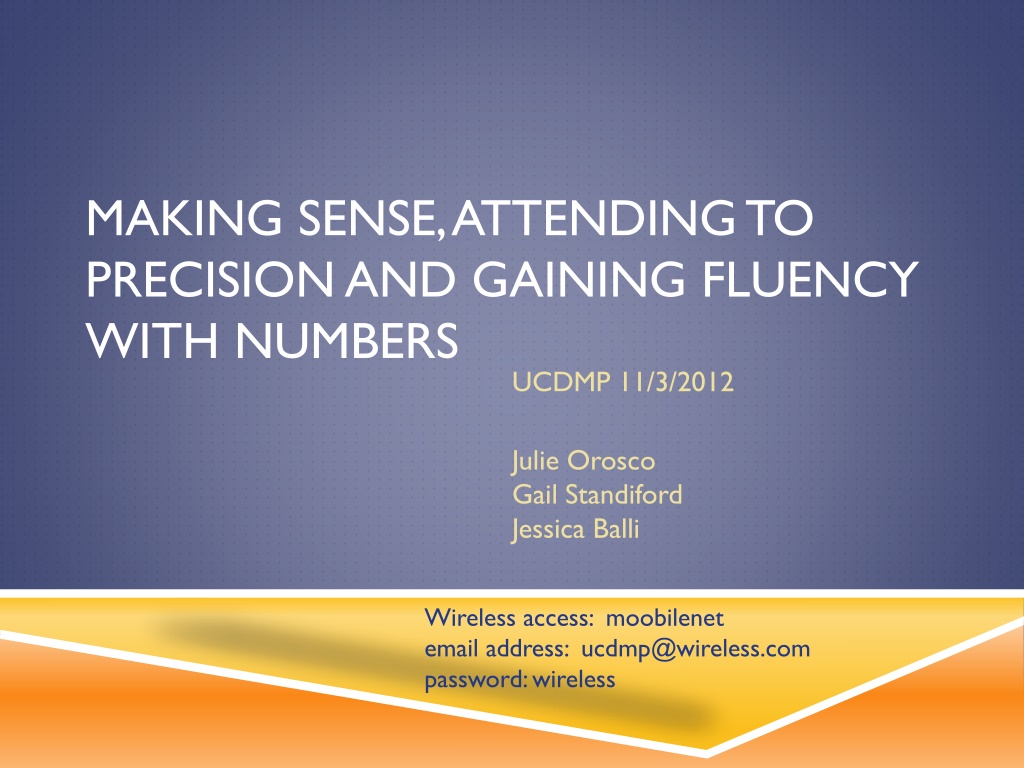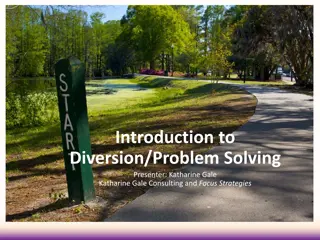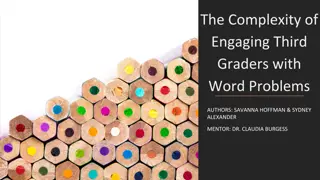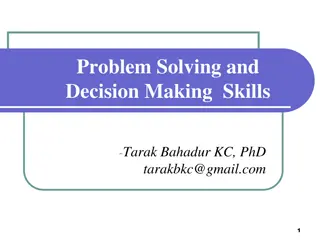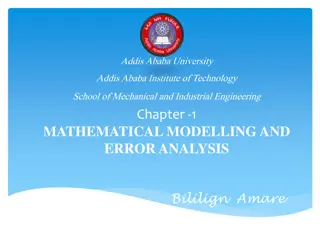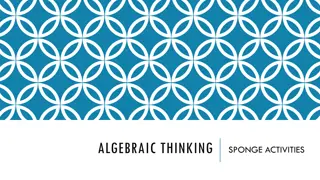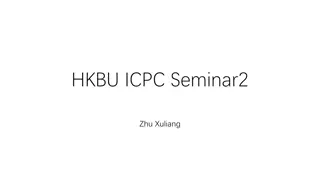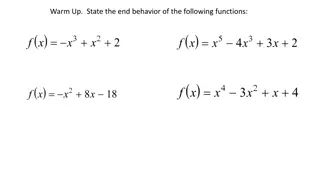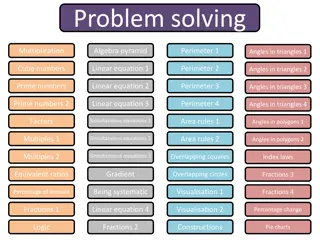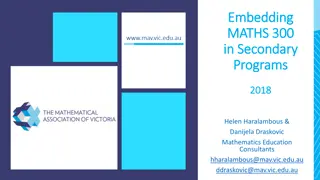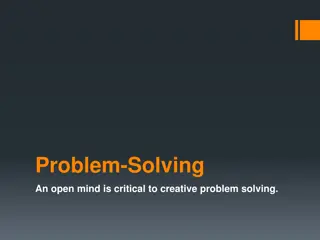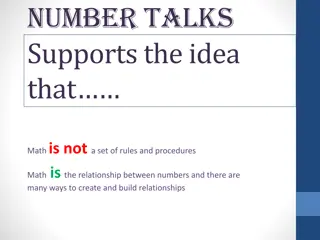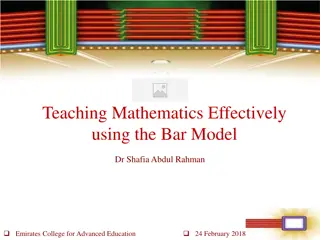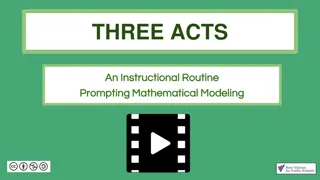Mathematical Practices and Problem-Solving Approaches
Explore the importance of mathematical practices and problem-solving strategies in gaining fluency with numbers. Discover resources such as King Arthur's Round Table activity and Common Core State Standards for Mathematics to enhance reasoning, precision, and mathematical modeling skills.
Download Presentation

Please find below an Image/Link to download the presentation.
The content on the website is provided AS IS for your information and personal use only. It may not be sold, licensed, or shared on other websites without obtaining consent from the author.If you encounter any issues during the download, it is possible that the publisher has removed the file from their server.
You are allowed to download the files provided on this website for personal or commercial use, subject to the condition that they are used lawfully. All files are the property of their respective owners.
The content on the website is provided AS IS for your information and personal use only. It may not be sold, licensed, or shared on other websites without obtaining consent from the author.
E N D
Presentation Transcript
MAKING SENSE, ATTENDING TO PRECISION AND GAINING FLUENCY WITH NUMBERS UCDMP 11/3/2012 Julie Orosco Gail Standiford Jessica Balli Wireless access: moobilenet email address: ucdmp@wireless.com password: wireless
King Arthurs Round Table If you knew how many knights were going to be at the table, how could you quickly determine where to stand so that you would win? Interactive Mathematics Program Small World, Isn t It?
COMMON CORE STATE STANDARDS FOR MATHEMATICS Two Types of Standards: Mathematical Practice (recurring throughout the grades) Mathematical Content (different at each grade level)
STANDARDS FOR MATHEMATICAL PRACTICE 1. Make sense of problems and persevere in solving them. 2. Reason abstractly and quantitatively. 3. Construct viable arguments and critique the reasoning of others. 4. Model with mathematics. 5. Use appropriate tools strategically. 6. Attend to precision. 7. Look for and make use of structure. 8. Look for and express regularity in repeated reasoning.
CCSS MATHEMATICAL PRACTICES REASONING AND EXPLAINING 2. Reason abstractly and quantitatively 3. Construct viable arguments are critique the reasoning of others OVERARCHING HABITS OF MIND 1. Make sense of problems and perseveres in solving them 6. Attend to precision 1. Make sense of problems and perseveres in solving OVERARCHING HABITS OF MIND MODELING AND USING TOOLS 4. Model with mathematics 5. Use appropriate tools strategically 6. Attend to precision SEEING STRUCTURE AND GENERALIZING 7. Look for and make use of structure 8. Look for and express regularity in repeated reasoning them
STANDARDS FOR MATHEMATICAL PRACTICE 1. Make sense of problems and persevere in solving them. 2. Reason abstractly and quantitatively. 3. Construct viable arguments and critique the reasoning of others. 4. Model with mathematics. 5. Use appropriate tools strategically. 6. Attend to precision. 7. Look for and make use of structure. 8. Look for and express regularity in repeated reasoning.
SMP 1: MAKE SENSE OF PROBLEMS AND PERSEVERE IN SOLVING THEM What does it mean to: Make sense of problems and persevere in solving them ? At your table, Round Robin* your thoughts about what this SMP means. *Round Robin: moving around the table clockwise, each person at the table states one thought/answer to a prompt.
SMP 1: MAKE SENSE OF PROBLEMS AND PERSEVERE IN SOLVING THEM Mathematically proficient students: start by explaining to themselves the meaning of a problem and looking for entry points to its solution. analyze givens, constraints, relationships, and goals. make conjectures about the form and meaning of the solution. plan a solution pathway rather than simply jumping into a solution attempt.
SMP 1: MAKE SENSE OF PROBLEMS cont. consider analogous problems, and try special cases and simpler forms of the original problem in order to gain insight into its solution. monitor and evaluate their progress and change course if necessary. check their answers to problems using a different method. continually ask themselves, Does this make sense? understand the approaches of others to solving complex problems and identify correspondences between approaches.
MAKING SENSE OF PROBLEMS AND PERSEVERING In 6th 8th grades, students solve real world problems through the application of algebraic and geometric concepts. They ask themselves, What is the most efficient way to solve the problem? , Does this make sense? , and Can I solve the problem in a different way?
MAKING SENSE OF PROBLEMS AND PERSEVERING High school students analyze givens, constraints, relationships, and goals. They make conjectures about the form and meaning of the solution and plan a solution pathway rather than simply jumping into a solution attempt. By high school, students can explain correspondences between equations, verbal descriptions, tables, and graphs or draw diagrams of important features and relationships, graph data, and search for regularity or trends.
SMP 6: ATTEND TO PRECISION What does it mean to: Attend to precision ? At your table, Round Robin* your thoughts about what this SMP means. *Round Robin: moving around the table clockwise, each person at the table states one thought/answer to a prompt.
SMP 6: ATTEND TO PRECISION Mathematically proficient students: try to communicate precisely to others. try to use clear definitions in discussion with others and in their own reasoning. state the meaning of the symbols they choose, including using the equal sign consistently and appropriately. carefully specify units of measure and label axes to clarify the correspondence with quantities in a problem. calculate accurately and efficiently, express numerical answers with a degree of precision appropriate for the problem context.
ATTENDING TO PRECISION In grades 6 8, students continue to refine their mathematical communication skills by using clear and precise language in their discussions with others and in their own reasoning. Students use appropriateterminology when referring to rates, ratios, geometric figures, data displays, components of expressions, equations or inequalities, probability models, the number system and functions.
ATTENDING TO PRECISION High school students try to communicate precisely to others by using clear definitions in discussion with others and in their own reasoning. They state the meaning of the symbols they choose, specifying units of measure, and labeling axes to clarify the correspondence with quantities in a problem. They calculate accurately and efficiently, express numerical answers with a degree of precision appropriate for the problem context. By the time they reach high school they have learned to examine claims and make explicit use of definitions.
GRADE 7 MATHEMATICS SAMPLE ER ITEM Consider a circle that has a circumference of 28?centimeters (cm). Part A What is the area, in cm2, of this circle? Show all work necessary to justify your response. Part B What would be the measure of the radius, in cm, of a circle with an area that is 20% greater than the circle in Part A? Show all work necessary to justify your response. Standard(s): Mathematical Practice(s): 7.G.4, 7.RP.3 1, 2, 6
HS MATHEMATICS SAMPLE ER ITEM The length, , and width, w, of the rectangle shown below have values that are rational numbers. Construct an informal proof that shows that the value of the area, in square feet, of the rectangle must be a rational number. Standard(s): Mathematical Practice(s): N-RN.3 1, 3, 6
POSTAGE STAMPS The post office has only 5 and 7 stamps. By combining different number of 5 and 7 stamps, customers can usually get the amount of postage they need. Which amounts of postage is it impossible to make using only 5 and 7 stamps?
K-8 Domains The Number System High School Categories Number and Quantity And MODELING!
GRADE 6: THE NUMBER SYSTEM Conceptual understanding and fluency with operations involving whole numbers, fractions, and decimals are critical for students success in mathematics at later grades. In the CCSS, sixth-grade students apply and extend their previous understanding of numbers to the system of rational numbers, which includes negative numbers. Sixth-graders apply properties of operations to add and subtract rational numbers.
GRADES 7-8: THE NUMBER SYSTEM Seventh-grade students apply and extend previous understandings of operations with fractions to add, subtract, multiply, and divide rational numbers, which include negative numbers. Students understand that properties of operations, such as the distributive property, apply to all rational numbers. Ultimately, students use the four operations with rational numbers to solve real-world and mathematical problems. Irrational numbers are introduced in seventh grade. Students use rational approximations of irrational numbers.
HIGH SCHOOL-NUMBER AND QUANTITY Students will be exposed to the complex numbers. The commutative, associative, and distributive properties extend the properties of operations to the integers, rational numbers, real numbers, and complex numbers. Extending the properties of exponents leads to new and productive notation. Students encounter a wider variety of units in modeling, e.g. acceleration, currency conversions, derived quantities such as person-hours and heating degree days, social science rates such as per-capita income, and rates in everyday life such as points scored per game or batting averages. They also encounter novel situations in which they themselves must conceive the attributes of interest.
NUMBER IN THE CCSS-M Look at the Number and Quantity standards at your grade level. How are they the same as your old standards? How are they different? Where they are different Which of these new concepts can you easily integrate into your current teaching? With what old standards do they fit? Which current number standards are not included in the CCSS? Can these standards be deemphasized to make room for the inclusion of new content?
SMARTER BALANCED ASSESSMENT The Smarter Balanced Assessment Consortium is creating next-generation assessments aligned to the Common Core State Standards (CCSS) in English language arts/literacy and mathematics. Just as the CCSS describe the knowledge and skills students need to be prepared for college and career, the system of computer adaptive assessments including summative and formative tests will provide important information about whether students are on track, as well as resources and tools for teachers to help students succeed. http://www.smarterbalanced.org/wordpress/wp-content/uploads/2012/02/Smarter- Balanced-Teachers.pdf
SBAC MATHEMATICS ASSESSMENT CLAIMS Claim 1: Concepts and Procedures (40%) Students can explain and apply mathematical concepts and interpret and carry out mathematical procedures with precision and fluency Claim 2: Problem Solving (20%) Students can solve a range of complex well-posed problems in pure and applied mathematics, making productive use of knowledge and problem solving strategies
SBAC MATHEMATICS ASSESSMENT CLAIMS Claim 3: Communicating Reasoning (20%) Students can clearly and precisely construct viable arguments to support their own reasoning and to critique the reasoning of others Claim 4: Modeling and Data Analysis (20%) Students can analyze complex, real-world scenarios and can construct and use mathematical models to interpret and solve problems
ASSESSMENT TARGETS Number of Assessment Targets Claim 1: Students can explain and apply mathematical concepts and interpret and carry out mathematical procedures with precision and fluency. Grade Level 3 11 4 12 5 11 6 10 7 9 8 10 11 16
ASSESSMENT TARGETS FOR NUMBER 6th Grade: The Number System B. Apply and extend previous understandings of multiplication and division to divide fractions by fractions. C. Compute fluently with multi-digit numbers and find common factors and multiples. D. Apply and extend previous understandings of numbers to the system of rational numbers.
ASSESSMENT TARGETS FOR NUMBER 7th Grade: The Number System B. Apply and extend previous understandings of operations with fractions to add, subtract, multiply, and divide rational numbers. 8th Grade: The Number System A. Know that there are numbers that are not rational, and approximate them by rational numbers.
ASSESSMENT TARGETS FOR NUMBER High School: Number and Quantity A. Extend the properties of exponents to rational exponents. B. Use properties of rational and irrational numbers. C. Reason quantitatively and use units to solve problems.
SBAC ITEM/TASK SPECIFICATIONS http://www.smarterbalanced.org/smarter-balanced-assessments/
SMARTER BALANCED ASSESSMENT Let s take a look at some of the sample items and performance tasks recently released by SBAC http://www.smarterbalanced.org/
